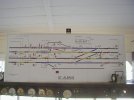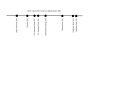Lets not forget what the ordnance survey was created for. It was part of the military. I dont think the military would be interested in types of signal or if a box is a signal box or a gate box.
It's a good question, but would such info normally ever be shown on an OS map
Good points - I've never seen on any map sheets signal box numbers, and can't think why the map makers would even note them except to mark the boxes themselves.
A distant signal refers to any stop signal in the section being entered. So if there are two or three stop signals they must all be cleared before the distant signal can be cleared.
Thanks John for the explanation and the photo from St. Albans box.
Where do these numbers (332, 333, etc.) appear? Without knowing more I would presume that they were internal Lancashire & Yorkshire Railway numbers (but possibly continuing in use long after), used either by the S&T or Control for some purpose.
These were internal L&Y numbers.
Padiham West has been confirmed as 333 and East 332. The details come from a book on L&Y signalling by the now sadly late Chris Littleworth, who by the way was a lovely guy and always very helpful.
Chris also confirms the box that protected the branch at the West junction (Great Harwood junction) was actually called Padiham junction. This original box was i
opened 17/6/1876. It had 22 levers and was brick built. It was situated on the Up line side of the East Lancashire side until 12/6/1898 when it was replaced by Great Harwood junction box. This new box was positioned away from the junction and placed on the Down line side and had 60 levers.
Going to the Eastern junction, the original box was called Rose Grove Junction, it had 13 levers and was brick built. It was inspected 28/2/1873 which gives us an approximate opening date. This was replaced in 1899 by Rose Grove West which was moved further away from the junction.
On another note - Now that I've found out about this original box at RG junction, I went back to measure from MP1 back to it. Guess what? This original box was actually the zero point for the branch.
Going back to the box numbers - I don't know when these numbers were first used by the L&Y. In 1895 a connection and sidings were installed to serve Martholme colliery together with a new box. This new box was No 335, going West, these box numbers are consecutive i.e. 336, 337 etc, so perhaps this numbering system came in with the new box?



